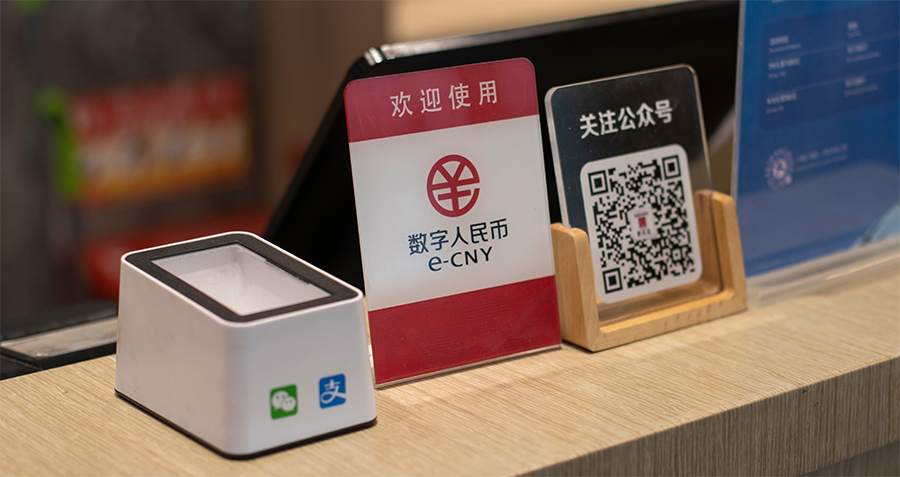On Single’s Day 2021, China’s largest online shopping festival, Tmall’s gross transaction volume (GMV) reached RMB 540 billion (USD $79 billion), a year-on-year increase of 8.5%, while JD.com’s GMV reached RMB 349 billion (USD $51 billion), a year-on-year rise of 28.6%. Under such intense e-commerce competition, it is rare that two established e-commerce companies can maintain these sort of growth rates, albeit at lower rates than before.
Both Alibaba and JD.com have enjoyed the profits of the e-commerce industry over the past two decades, however, both are now striving to veer away from their ‘e-commerce-dependent’ growth models, and branch into other areas. In early 2019, David Zhang, the CEO of Alibaba, highlighted some of the areas the company would move into, including international expansion, big data, and cloud computing. Meanwhile, the current CEO of JD.com, Xue Lei said the company’s will focus would be on digital upgrading and the decentralization of its retail business.
What is intriguing is that in 2021, although JD’s revenue exceeded that of Alibaba by over 100 million, Alibaba made ten times the net profit of JD.com with twice as many active users.
This case study will look at how Alibaba and JD.com have carved out their success over the last two decades, despite possessing e-commerce models that have evolved so differently.

The ‘Flywheel Effect’
The ‘flywheel effect’, first coined by Jim Collins in his book, “Good to Great” and used by Amazon founder Jeff Bezos in 2001, provides a reference tool to understand the business models of Alibaba and JD.com. The flywheel effect happens when small wins build on each other over time and eventually gains enough momentum will keep the business growing and become self-sustaining, just like momentum created by a mechanical flywheel. It takes a lot of effort to turn from static to rotation at the start, but once it starts to rotate the entire gear set will follow, turning faster and faster. For Amazon, this initial push was the lowering of its prices, which resulted in greater customer traffic. Third-party sellers were subsequently drawn to the platform which boosted its sales and distribution channels, and in turn boosted Amazon’s contribution margin (the marginal profit per unit sale). As profits increased, Amazon could reduce its prices further. Subsequently through expansion into related areas the growth continues.

The Rise of Taobao
In 2002, as soon as Alibaba moved into the B2B market, it faced a challenge: eBay, which operated a customer-to-customer (C2C) model. It was not only having huge success in the United States and Europe, but had also broken into the Chinese market after its acquisition of the Chinese e-commerce company Eachnet.com for RMB 150 million in 2003. Wanting to protect its wholesale platform, 1688, and to enter the C2C e-commerce market, Alibaba established Taobao in 2003. This started an e-commerce war with eBay. Jack Ma, the founder of the Alibaba said, “eBay wanted to buy the entire Chinese market; we wanted to create an online marketplace.” Taobao would eventually become so successful that it led to eBay exiting from the Chinese market in 2006.
Taobao, which allows individuals and small business owners to sell their products by setting up their own stores on the platform, was just the ‘flywheel’ for Alibaba’s future expansion. Alipay, which provided an efficient and safe method for individuals to send and receive payments, was subsequently launched in 2003. Moreover, a year later Alibaba established the communication software Aliwangwang to enable users to communicate with Taobao sellers.
By 2005, Taobao’s annual turnover exceeded RMB 8 billion, surpassing even that of Walmart China. Taobao also overtook Yahoo! Japan in terms of its number of transactions and the quantity of products on its platform, becoming Asia’s largest online shopping platform. Taobao managed to carve out a unique space in the Chinese market by offering niche and personalised products on its platform – ‘Taobao’ in Chinese means ‘hunting for treasure’.
JD.com Emerging from the SARS Virus
At a time when Alibaba occupied half of China’s e-commerce market, JD Multimedia (later to become JD.com) began to emerge in Zhongguancun, Beijing’s technology hub, as a dealer in magneto-optical products. Just when Liu Qiangdong, JD.com’s founder, was planning the company’s expansion in 2002, the SARS pandemic broke out in China.
Beijing was one of the hardest hit areas with almost all stores in the city having to halt operations. Subsequently, Liu Qiangdong moved his business online, and even helped his team make product deliveries. After the economy opened again, JD had established itself as a ‘high quality, low price and fast delivery’ brand. Liu closed the company’s offline stores and placed all his bets on the online business.
The C2C model had reached unprecedented highs in popularity at the beginning of the century due to the success of eBay and Eachnet.com. With a C2C model, companies didn’t need to transport goods nor build warehouses – as long as there is protection guaranteed on customers’ orders and the platform provides a relatively good user experience, the intermediary can earn commission without any operational or inventory risk.
Liu and his team at JD considered whether to use a C2C model. JD initially manufactured ‘3C digital appliances’ – computers, communications and consumer electronics equipment. These high-end products required after-sales services, therefore control of pricing, product quality and services were fundamental. For this reason Liu chose to launch the platform with a business-to-consumer (B2C) model in 2004 under the name JD Multimedia. By June 2007 annual sales reached RMB 360 million and since then JD has become a giant in the B2C e-commerce field.
Alibaba: the ‘Information Intermediary’
To get the flywheel started Alibaba and JD.com adopted different methods – Alibaba constructed a network of merchants and consumers but did not deal or own rights to any of the products on their platform. It acts as an ‘information intermediary’ whereby the more information the platform obtains, the more successful the platform becomes. The platform earns a profit from transaction commissions and advertising; as Alibaba’s user base grows, it is able to reduce the transaction fees it charges. Four years after its establishment, Taobao had expanded to an annual transaction volume exceeding 16.9 billion. Its registered users reached 30 million and its goods covered digital products, cosmetics, virtual goods, jewelry, and apparel.
JD: The ‘Merchant Intermediary ‘
JD, on the other hand, was founded on the philosophy of a ‘merchant intermediary’ where it profits from the price difference between product procurement and product sales. The company is more focused on indicators such as gross profit margins, asset turnover and product quality, and the company must take responsibility for inventory risks and costs.
Initially JD’s business was self-operated and only dealt in consumer electronics; however, in 2010 JD opened its platform to third-party sellers as well as expanded its product range. It launched a book selling business which gradually branched out into other categories including apparel, daily necessities, and luxury products. Since then JD has developed online music, travel, grocery delivery and health platforms.
According to JD.com’s financial reports, in 2020, its stock-keeping units (SKU) reached 5 million. In comparison, U.S. retail giant Walmart, has less than 30,000 SKUs and Costco only 4000.

Alibaba’s Traffic Expansion: Tmall, Alipay and Cainiao
After Taobao’s success Jack Ma looked to expand into the B2C market. In April 2008 he established Tmall, a platform for third-party brands and retailers, enabling them to sell their products either directly or indirectly through franchised stores. With Tmall, Alibaba took greater responsibility for quality control of its products with the aim to address the authenticity issues associated with Taobao. In comparison to Taobao which profits from transaction fees and advertising, Tmall enables Alibaba to obtain revenue from a wider scope of channels, including set-up fees, sales commissions, warehousing, optional delivery services and online marketing services.
Later in April 2010 Alibaba expanded overseas with the launch of AliExpress – an online trading platform which allows small businesses in China to sell to international consumers. Juhuashan, a group shopping platform, was also launched at this time.
Another area Alibaba explored was internet finance: due to the popularity of Alipay – used as a payment service for Taobao since 2003 – Alibaba announced in March 2013 the establishment of a micro-financial service group (which would eventually become Ant Group). Ant Group essentially lowered the entry threshold and cost for consumers and small businesses, integrating them into a financial ecosystem which covers credit and insurance services.
To add to its e-commerce ecosystem Alibaba launched Cainiao Smart Logistics Network in 2013 to integrate logistics with smart supply chain management. With the rise in orders there was an inevitable increase in demand for product returns. Cainiao enabled Taobao to increase the efficiency of its returns capabilities and operate a ‘seven days free return’ policy. By 2020, Cainiao covered many industries such as warehouse storage, express delivery and smart supply chain solutions. It ships more than 4 million parcels daily and has accumulated 200 million monthly users using its express delivery platform.
More recently, Alibaba has moved into lifestyle services – Alibaba purchased the food delivery company Ele.me and merged it with its own brand Koubei in 2018 to cover sectors such as food delivery, beauty and travel.

Advertising is Alibaba’s Biggest Revenue Generator
Alibaba’s largest revenue generator is from its advertising business, contrary to the commonly held view that it would be from commissions from transactions. Its advertising business on Taobao and Tmall is conducted by its subsidiary Alimama, which was launched in 2010. Alimama was so successful that after a year it surpassed Baidu as China’s largest advertising platform. Recently, Alimama has built various marketing services such as the precision marketing tool, Damopan, and the pay-per-click marketing tool, Zhitongche.
In 2021, commercial transactions accounted for 87% of Alibaba’s total revenue – this encompasses its retail business (Tmall and Taobao), its international business, wholesale, Cainiao and local services. The remaining revenue stems from cloud computing, media and entertainment and its digital business. Within commercial transactions, retail contributed 66% of the total revenue. Moreover, within retail itself, 30% of the revenue came from advertising and 12% from commissions.

JD’s Revenue Structure
Whereas Alibaba’s main revenue sources come from advertising and transaction commissions, JD’s revenue structure is different. According to the company’s financial reports, the company’s main source of revenue is two-fold: one is the income it gains from the products it sells on its platform; the other comes from the services it provides including fees from third-party merchants who use its platform, advertising, and logistics services. Nonetheless, 90% of JD’s revenue comes from its self-operated businesses which is in stark contrast to Alibaba.

JD’s Traffic Expansion: Creating an Integrated Supply Chain
A big step in JD’s expansion was the development of its own logistics network. Logistical services in China were not well-developed before 2007 when JD was using third-party companies to deliver its products: these companies often damaged or failed to deliver its highly valuable products. JD subsequently developed its own delivery network in July 2007 which stretched across Beijing, Shanghai and Guangzhou, covering an area of 50,000 square kilometers. It also developed its own warehouse management system in 2010.
After JD allowed third-party merchants on its platform and expanded its product range, both the number of brands and users on its platform increased significantly. Brands were drawn to the platform due to the flexibility it offered. Brands could either ask JD to operate their online store for them or they could operate the store themselves and use JD’s distribution network. Recently, JD has expanded its logistical services further – offering warehousing, distribution, and after-sale services. JD Logistics has become so successful in that in May 2021 it spun-off from JD.com, launching an IPO in Hong Kong.
Another important step for JD.com was the improvement of its financial service business. JD Finance (later re-named JD Digits) was established in 2013, offering financial services to consumers and small companies including loans, payment solutions, asset management and crowdfunding. JD Digits also assists self-operating suppliers and third-party merchants with purchasing, warehousing, and processing settlement guarantee funds. Through supply-chain finance, JD Digits has mitigated the long-existing problem of financial risk in physical supply chains. Getting closer to suppliers has increased JD’s supply-chain efficiency.
JD has not relied on procuring products at low prices from suppliers to increase revenue. Instead, the company has created an integrated supply chain – reducing losses, increasing inventory turnover, and thereby reducing costs. According to JD’s financial reports, its fulfillment costs declined to approximately 6% in 2021. JD’s inventory turnover has also shrunk from 50 days in 2011 to 28 days in the first half of 2021.

The New Era of Retail
In 2016, Jack Ma proposed the new concept of “new retail” – the idea that the era of pure e-commerce is coming to an end. This concept quickly sparked discussion in the media, business, and academic circles. Within a year, JD.com also proposed the idea of “borderless retail”. Xu Lei said in 2017 that everything from consumers to supply chains to marketing are all going through major transformations.

In recent years, the growth rate of e-commerce has slowing decreased. As the saying goes, internet companies are not afraid of not making a profit, what they fear is a slowdown of growth. Jack Ma said, “from next year, Alibaba will no longer mention e-commerce – it is just a ferry boat that will be capsized in the future.” Daniel Zhang, the current CEO of Alibaba highlighted the company would move into new areas such as international expansion, big data, the domestic market and cloud computing in a letter to stakeholders in early 2019.
Liu Qiangdong from JD said, “the nature of retail has never changed – it has always been about costs, efficiency, and user experience. But as technology develops and consumption upgrades, the value created changes. In the future, JD.com will focus on service infrastructure and will provide Retail as a Service (RaaS) solutions to the whole of society.”
The history of these two companies shows the ‘growth flywheel’ that Bezos described in operation. Alibaba essentially works in the ‘information intermediary’ market whilst JD.com is more of a typical ‘merchant intermediary’. It is this fundamental difference in their e-commerce business models which gave birth to their individual distinctive flywheel structures, and which has directly led to the rivalry between the two for nearly two decades. Who will lose out or can these two companies continue their growth? Only time will tell.



















